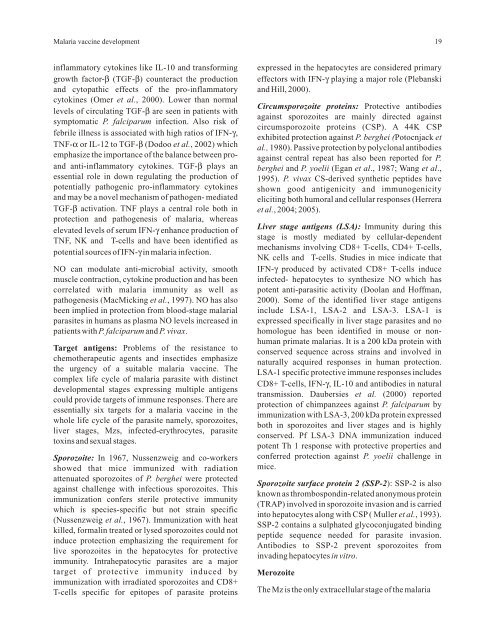PDF File - The Indian Society for Parasitology
PDF File - The Indian Society for Parasitology
PDF File - The Indian Society for Parasitology
You also want an ePaper? Increase the reach of your titles
YUMPU automatically turns print PDFs into web optimized ePapers that Google loves.
Malaria vaccine development19inflammatory cytokines like IL-10 and trans<strong>for</strong>ming expressed in the hepatocytes are considered primarygrowth factor-β (TGF-β) counteract the production effectors with IFN-γ playing a major role (Plebanskiand cytopathic effects of the pro-inflammatory and Hill, 2000).cytokines (Omer et al., 2000). Lower than normalCircumsporozoite proteins: Protective antibodieslevels of circulating TGF-β are seen in patients withagainst sporozoites are mainly directed againstsymptomatic P. falciparum infection. Also risk ofcircumsporozoite proteins (CSP). A 44K CSPfebrile illness is associated with high ratios of IFN-γ,exhibited protection against P. berghei (Potocnjack etTNF-α or IL-12 to TGF-β (Dodoo et al., 2002) which al., 1980). Passive protection by polyclonal antibodiesemphasize the importance of the balance between pro- against central repeat has also been reported <strong>for</strong> P.and anti-inflammatory cytokines. TGF-β plays an berghei and P. yoelii (Egan et al., 1987; Wang et al.,essential role in down regulating the production of 1995). P. vivax CS-derived synthetic peptides havepotentially pathogenic pro-inflammatory cytokines shown good antigenicity and immunogenicityand may be a novel mechanism of pathogen- mediated eliciting both humoral and cellular responses (HerreraTGF-β activation. TNF plays a central role both in et al., 2004; 2005).protection and pathogenesis of malaria, whereaselevated levels of serum IFN-γ enhance production ofLiver stage antigens (LSA): Immunity during thisTNF, NK and T-cells and have been identified asstage is mostly mediated by cellular-dependentmechanisms involving CD8+ T-cells, CD4+ T-cells,potential sources of IFN-γ in malaria infection.NK cells and T-cells. Studies in mice indicate thatNO can modulate anti-microbial activity, smooth IFN-γ produced by activated CD8+ T-cells inducemuscle contraction, cytokine production and has been infected- hepatocytes to synthesize NO which hascorrelated with malaria immunity as well as potent anti-parasitic activity (Doolan and Hoffman,pathogenesis (MacMicking et al., 1997). NO has also 2000). Some of the identified liver stage antigensbeen implied in protection from blood-stage malarial include LSA-1, LSA-2 and LSA-3. LSA-1 isparasites in humans as plasma NO levels increased in expressed specifically in liver stage parasites and nopatients with P. falciparum and P. vivax.homologue has been identified in mouse or nonhumanprimate malarias. It is a 200 kDa protein withTarget antigens: Problems of the resistance toconserved sequence across strains and involved inchemotherapeutic agents and insectides emphasizenaturally acquired responses in human protection.the urgency of a suitable malaria vaccine. <strong>The</strong>LSA-1 specific protective immune responses includescomplex life cycle of malaria parasite with distinctCD8+ T-cells, IFN-γ, IL-10 and antibodies in naturaldevelopmental stages expressing multiple antigenstransmission. Daubersies et al. (2000) reportedcould provide targets of immune responses. <strong>The</strong>re areprotection of chimpanzees against P. falciparum byessentially six targets <strong>for</strong> a malaria vaccine in theimmunization with LSA-3, 200 kDa protein expressedwhole life cycle of the parasite namely, sporozoites,both in sporozoites and liver stages and is highlyliver stages, Mzs, infected-erythrocytes, parasiteconserved. Pf LSA-3 DNA immunization inducedtoxins and sexual stages.potent Th 1 response with protective properties andSporozoite: In 1967, Nussenzweig and co-workers conferred protection against P. yoelii challenge inshowed that mice immunized with radiation mice.attenuated sporozoites of P. berghei were protectedSporozoite surface protein 2 (SSP-2): SSP-2 is alsoagainst challenge with infectious sporozoites. Thisknown as thrombospondin-related anonymous proteinimmunization confers sterile protective immunity(TRAP) involved in sporozoite invasion and is carriedwhich is species-specific but not strain specificinto hepatocytes along with CSP ( Muller et al., 1993).(Nussenzweig et al., 1967). Immunization with heatSSP-2 contains a sulphated glycoconjugated bindingkilled, <strong>for</strong>malin treated or lysed sporozoites could notpeptide sequence needed <strong>for</strong> parasite invasion.induce protection emphasizing the requirement <strong>for</strong>Antibodies to SSP-2 prevent sporozoites fromlive sporozoites in the hepatocytes <strong>for</strong> protectiveinvading hepatocytes in vitro.immunity. Intrahepatocytic parasites are a majortarget of protective immunity induced by Merozoiteimmunization with irradiated sporozoites and CD8+T-cells specific <strong>for</strong> epitopes of parasite proteins <strong>The</strong> Mz is the only extracellular stage of the malaria










